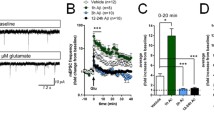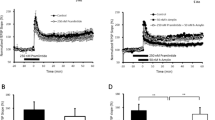Abstract
Intracerebroventricular administration of aggregated β-amyloid protein fragment (25–35) (7.5 nmol/ventricle) was followed one month later by significant changes in the dynamics of long-term potentiation in the hippocampus in vivo, expressed as powerful and stable increases in the amplitude of evoked potentials. This phenomenon may be associated with oxidative stress in the hippocampus, which has previously been demonstrated in this model, and, thus, with disturbances in ion homeostasis.
Similar content being viewed by others
REFERENCES
O. S. Mitrokhina, M. Yu. Stepanichev, N. A. Lazareva, et al., “The effects of intracerebroventricular administration of fragment (25-35) of β-amyloid peptide on lipid peroxidation levels in rat brain structures and blood,” Dokl. Ros. Akad. Nauk., 368, No. 5, 711–713 (1999).
M. Yu. Stepanichev, N. A. Lazareva, M. V. Onufriev, et al., “The effects of administration of a β-amyloid peptide fragment on behavior in rats, ”Zh. Vyssh. Nerv. Deyat., 47, No. 3, 597–600 (1997).
B. Carette, P. Poulain, and A. Delacourt, “Electrophysiological effects of 25-35 amyloid-β-protein on guinea-pig lateral septal neurons, ”Neurosci. Lett., 5, 111–114 (1993).
P. F. Chapman, G. L. White, M. W. Jones, et al., “Impaired synaptic plasticity and learning in aged amyloid precursor protein transgenic mice,” Nat. Neurosci., 2, 271–276 (1999).
Q.-S. Chen, B. Kagan, Y. Hirakura, and C.-W. Xie, “Impairment of hippocampal long-term potentiation by Alzheimer amyloid β-peptides,” J. Neurosci. Rear-End shunt., 60, 65–72 (2000).
W. K. Cullen, Y.-H. Suh, R. Anwyl, and M. J. Rowan, “Block of LTP in rat hippocampus in vivo by β-amyloid precursor protein fragments,” NeuroReport, 8, 3213–3217 (1997).
S. Delobette, A. Privat, and T. Maurice, “In vitro aggregation facilitates beta-amyloid peptide-(25-35)-induced amnesia in the rat,” Eur. J. Pharmacol., 319, 1–4 (1997).
N. V. Gulyaeva, I. V. Viktorov, M. Yu. Stepanichev, et al., “Intracerebroventricular administration of beta-amyloid peptide (25-35) induces oxidative stress and neurodegeneration in rats brain,” in: Progress in Alzheimer's and Parkinson's Disease, A. Fisher et al. (eds.), Plenum Press, New York (1998), pp. 89–98.
C. Holsher, “β-amyloid induced reduction in synaptic transmission is reversed by inhibitors of nitric oxide synthase,” NeuroReport, 9, 1245–1248 (1998).
N. Kowall, A. McKee, B. Yankner, and M. Beal, “In vivo neurotoxicity of beta-amyloid [beta(1-40)] and the beta(25-35) fragment,” Neurobiol. Aging., 13, 537–542 (1992).
V. Markevich, A. M. Scorsa, G. S. Dawe, and J. D. Stephenson, “Cholinergic facilitation and inhibition of long-term potentiation of CA1 pyramidal cells in the hippocampus of urethane-anaesthetized rats,” Brain Res., 754, 95–102 (1997).
M. P. Mattson, “Modification of ion homeostasis by lipid peroxidation: roles in neuronal degeneration and adaptive plasticity,” Trends. Neurosci., 21, 53–57 (1998).
T. Maurice, B. Lockhart, and A. Privat, “Amnesia induced in mice by centrally administered beta-amyloid peptides involves cholinergic dysfunction,” Brain Res., 706, 181–189 (1996).
M. P. McDonald and J. B. Overmier, “Present imperfect: A critical review of animal models of the mnemonic impairments in Alzheimer's disease,” Neurosci. Biobehav. Rev., 22, 99–120 (1998).
J. Nalbantoglu, G. Tirado-Santiago, A. Lahsaini, et al., “Impaired learning and LTP in mice expressing the carboxy terminus of the Alzheimer amyloid precursor protein,” Nature, 387, 500–505 (1997).
G. Paxinos and C. Watson, The Rat Brain in Stereotaxic Coordinates, Academic Press, New York, London.
M. Yu. Stepanichev, M. Yu. Onufriev, O. S. Mitrokhina, et al., “Neurochemical, behavioral, and neuromorphological effects of central administration of beta-amyloid peptide (25-35) in rat,” Neirokhimiya, 17, 291–306 (2000).
W. Sweeney, J. Luedtke, M. P. McDonald, and J. B. Overmier, “Intrahippocampal β-amyloid impairs win-shift radial maze performance in rats,” Neurobiol. Learn. Memory, 68, 97–101 (1997).
R. D. Terry, E. Masliah, and L. A. Hansen, “Structural basis of cognitive alterations in Alzheimer's disease,” in: Alzheimer Disease, R. D. Terry, R. Katzman, and N. Bick (eds.), Raven Press, New York (1994), pp. 179–196.
J. Wu, R. Anwyl, and M. J. Rowan, “β-Amyloid selectively augments NMDA receptor-mediated synaptic transmission in rat hippocampus,” NeuroReport, 6, 2409–2413 (1995).
J. Wu, R. Anwyl, and M. J. Rowan, “Beta-amyloid (1-0-40) increases long-term potentiation in rat hippocampus in vitro,” Eur. J. Pharmacol., 284, 1–3 (1995).
O. Yermolaeva, N. Brot, H. Weissback, et al., “Reactive oxygen species and nitric oxide mediate plasticity of neuronal calcium signaling,” Proc. Natl. Acad. Sci. USA, 97, 448–453 (2000).
S. Yan, X. Chen, J. Fu, et al., “RAGE and amyloid β-peptide neurotoxicity in Alzheimer's disease,” Nature, 382, 685–691 (1996).
B. Yankner, L. Duffy, and D. Kirshner, “Neurotropic and neurotoxic effects of amyloid β protein: Reversal by tachykinin neuropeptides,” Science, 250, 279–282 (1990).
Author information
Authors and Affiliations
Rights and permissions
About this article
Cite this article
Trubetskaya, V.V., Stepanichev, M.Y., Onufriev, M.V. et al. Administration of Aggregated Beta-Amyloid Peptide (25–35) Induces Changes in Long-Term Potentiation in the Hippocampus in Vivo. Neurosci Behav Physiol 33, 95–98 (2003). https://doi.org/10.1023/A:1021761310435
Issue Date:
DOI: https://doi.org/10.1023/A:1021761310435




